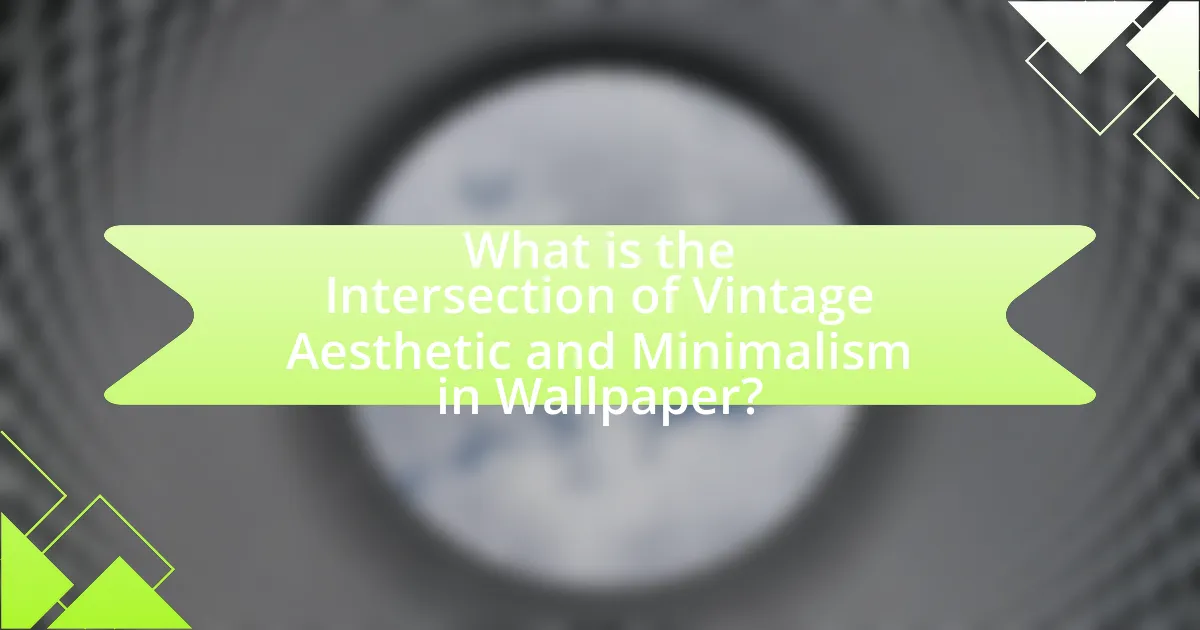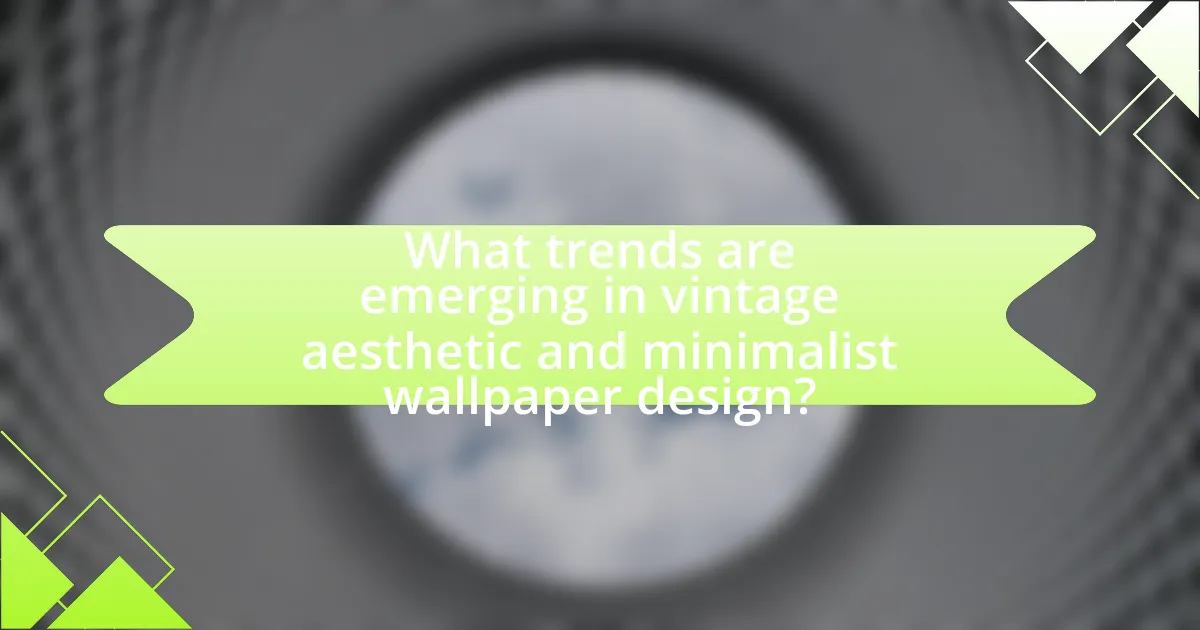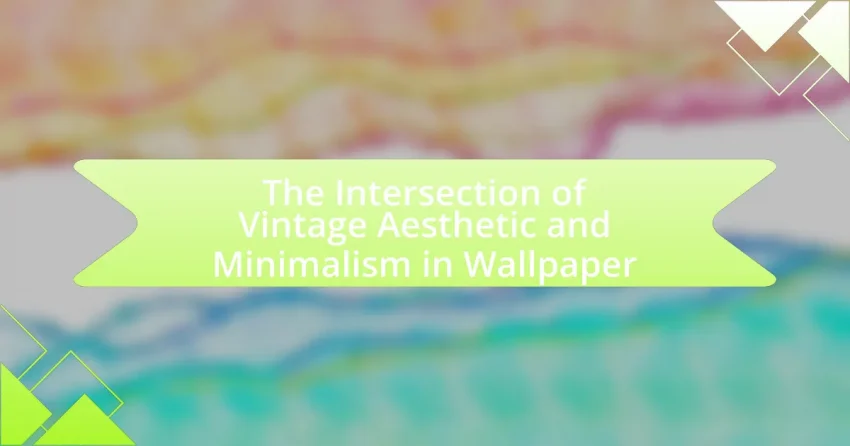The article explores the intersection of vintage aesthetic and minimalism in wallpaper design, highlighting how nostalgic elements can be harmoniously integrated with a simplified, modern approach. It discusses the characteristics of vintage aesthetics, including intricate patterns and muted color palettes, and contrasts these with minimalist principles that emphasize clean lines and functionality. The article also examines the influence of vintage styles on contemporary wallpaper design, the role of color palettes, and the practical applications of these designs in various interior spaces. Additionally, it addresses emerging trends, challenges in combining the two styles, and best practices for selecting and maintaining wallpaper that embodies both vintage charm and minimalist simplicity.

What is the Intersection of Vintage Aesthetic and Minimalism in Wallpaper?
The intersection of vintage aesthetic and minimalism in wallpaper is characterized by the fusion of nostalgic design elements with a simplified, uncluttered approach. Vintage wallpaper often features intricate patterns, textures, and historical motifs, while minimalism emphasizes clean lines, open spaces, and a reduction of visual noise. This combination results in wallpaper designs that retain the charm and character of vintage styles but are presented in a more subdued and modern context, allowing for a harmonious balance between the ornate and the simple. For example, a vintage floral pattern may be rendered in a muted color palette and applied in a sparse manner, aligning with minimalist principles while still evoking a sense of history and warmth.
How do vintage aesthetics influence modern wallpaper design?
Vintage aesthetics significantly influence modern wallpaper design by inspiring patterns, color palettes, and textures that evoke nostalgia while integrating contemporary minimalism. Designers often draw from historical motifs, such as Art Deco or Victorian styles, to create wallpapers that blend intricate designs with modern simplicity. For instance, the resurgence of botanical prints and damask patterns in contemporary collections reflects a desire to connect with the past while maintaining a clean, uncluttered look. This fusion allows modern wallpaper to serve as both a statement piece and a subtle backdrop, appealing to consumers seeking a balance between vintage charm and modern functionality.
What characteristics define vintage aesthetics in wallpaper?
Vintage aesthetics in wallpaper are characterized by intricate patterns, muted color palettes, and nostalgic motifs that evoke a sense of history and craftsmanship. These wallpapers often feature floral designs, damask patterns, or geometric shapes that reflect design trends from the late 19th to mid-20th centuries. The use of textured materials and finishes, such as linen or embossed surfaces, further enhances the vintage feel. Historical context supports this, as wallpaper styles evolved significantly during the Victorian era, where elaborate designs were a hallmark of interior decoration, making vintage wallpaper a representation of that rich artistic heritage.
How do color palettes play a role in vintage wallpaper designs?
Color palettes are essential in vintage wallpaper designs as they evoke specific historical periods and aesthetic movements. For instance, the use of muted tones and earth colors in Victorian-era wallpapers reflects the natural materials and craftsmanship of that time, while brighter, bolder colors in Art Deco designs signify a shift towards modernity and luxury. Historical analysis shows that color choices in vintage wallpaper not only enhance the visual appeal but also communicate cultural narratives and social values of their respective eras, such as the preference for pastel shades in the 1950s that aligned with post-war optimism.
What is minimalism in the context of wallpaper?
Minimalism in the context of wallpaper refers to a design approach that emphasizes simplicity, functionality, and the use of minimal decorative elements. This style often features clean lines, neutral color palettes, and unobtrusive patterns, allowing for a serene and uncluttered aesthetic. The minimalist wallpaper design prioritizes open space and subtle textures, which can enhance the overall ambiance of a room without overwhelming it. This approach aligns with the broader principles of minimalism, which advocate for reducing excess and focusing on essential elements in design.
What are the key principles of minimalist wallpaper design?
The key principles of minimalist wallpaper design include simplicity, functionality, and a focus on color and texture. Simplicity is achieved through the use of clean lines and uncluttered patterns, allowing the wallpaper to enhance rather than dominate a space. Functionality emphasizes the practical aspects of wallpaper, ensuring it serves its purpose without unnecessary embellishments. Additionally, a limited color palette, often featuring neutral tones, is used to create a calming atmosphere, while texture can add depth without complexity. These principles align with the broader minimalist philosophy, which values the essence of design over excessive ornamentation.
How does minimalism affect the choice of patterns and textures in wallpaper?
Minimalism significantly influences the choice of patterns and textures in wallpaper by favoring simplicity and understated elegance. In minimalist design, the emphasis is placed on clean lines and a limited color palette, which leads to the selection of wallpapers that feature subtle patterns or textures rather than bold, intricate designs. For instance, wallpapers may incorporate soft geometric shapes or natural textures that add depth without overwhelming the space. This approach aligns with the minimalist philosophy of creating a serene environment, as seen in contemporary interior design trends that prioritize functionality and aesthetic clarity.
How do vintage aesthetics and minimalism complement each other in wallpaper?
Vintage aesthetics and minimalism complement each other in wallpaper by merging nostalgic design elements with a clean, uncluttered approach. Vintage wallpaper often features intricate patterns and historical motifs, which evoke a sense of warmth and character, while minimalism emphasizes simplicity and functionality. This combination allows for the use of vintage patterns in a restrained manner, creating a visually appealing space that retains personality without overwhelming the senses. For instance, a vintage floral pattern in muted colors can enhance a minimalist room by adding depth and interest, while still adhering to the minimalist principle of less is more. This synergy is evident in contemporary interior design, where vintage-inspired wallpapers are often used to create focal points in otherwise minimalist spaces, effectively balancing the richness of history with modern simplicity.
What are the common themes found at the intersection of these two styles?
The common themes found at the intersection of vintage aesthetic and minimalism in wallpaper include simplicity, nostalgia, and texture. Simplicity is evident as both styles prioritize clean lines and uncluttered designs, allowing for a serene environment. Nostalgia arises from vintage elements that evoke memories and historical references, while minimalism strips away excess to highlight these nostalgic features. Texture plays a crucial role, as vintage wallpapers often incorporate rich materials that add depth, complementing the minimalist focus on tactile experiences. These themes create a harmonious blend that celebrates both the past and the present in interior design.
How can vintage elements be simplified to fit a minimalist approach?
Vintage elements can be simplified to fit a minimalist approach by focusing on essential forms, neutral color palettes, and functional designs. This involves selecting vintage pieces that emphasize clean lines and avoiding overly ornate details, which can clutter a space. For instance, a vintage chair with a simple silhouette can be paired with a monochromatic color scheme to maintain a minimalist aesthetic. Research indicates that minimalism thrives on the principle of “less is more,” which aligns with the vintage philosophy of quality over quantity, allowing for a harmonious blend of both styles.

What are the practical applications of vintage and minimalist wallpaper designs?
Vintage and minimalist wallpaper designs have practical applications in interior design, enhancing aesthetic appeal while maintaining functionality. Vintage wallpaper can evoke nostalgia and character in spaces, making it suitable for residential homes, cafes, and boutique hotels, where a unique atmosphere is desired. Minimalist wallpaper, characterized by simple patterns and neutral colors, is often used in modern offices and homes to create a clean, uncluttered environment that promotes focus and tranquility.
The effectiveness of these designs is supported by studies indicating that well-designed environments can influence mood and productivity. For instance, a study published in the Journal of Environmental Psychology found that aesthetically pleasing spaces can enhance well-being and creativity. Thus, both vintage and minimalist wallpaper serve to improve the ambiance of various settings while catering to specific design preferences.
How can vintage minimalist wallpaper enhance interior spaces?
Vintage minimalist wallpaper enhances interior spaces by providing a timeless aesthetic that combines simplicity with historical charm. This type of wallpaper often features subtle patterns and muted colors, which can create a serene atmosphere while adding depth to a room. Research indicates that minimalist designs can reduce visual clutter, promoting a sense of calm and focus, which is particularly beneficial in modern living environments. Additionally, vintage elements can evoke nostalgia and warmth, making spaces feel more inviting. The combination of these characteristics allows vintage minimalist wallpaper to transform interiors into cohesive, stylish environments that reflect both personal taste and a connection to the past.
What types of rooms benefit most from this wallpaper style?
Rooms that benefit most from the intersection of vintage aesthetic and minimalism in wallpaper include living rooms, bedrooms, and home offices. These spaces often require a balance of style and comfort, which vintage-inspired minimalist wallpaper can provide by adding character without overwhelming the decor. For instance, living rooms can utilize subtle vintage patterns to create a warm and inviting atmosphere, while bedrooms can achieve a serene environment with soft, muted designs. Home offices benefit from minimalist wallpaper that promotes focus and productivity, allowing for a stylish yet uncluttered workspace.
How does the choice of wallpaper affect the overall ambiance of a space?
The choice of wallpaper significantly influences the overall ambiance of a space by establishing mood, style, and visual interest. Different patterns, colors, and textures can evoke various emotions; for instance, soft pastels create a calming effect, while bold patterns can energize a room. Research indicates that color psychology plays a crucial role in how individuals perceive their environment, with specific hues linked to feelings of tranquility or excitement. Additionally, the integration of vintage aesthetics with minimalism can enhance a space’s character, providing a sense of nostalgia while maintaining a clean, uncluttered look. This combination can lead to a harmonious balance that enriches the ambiance, making it both inviting and stylish.
What are the challenges of combining vintage aesthetics with minimalism in wallpaper?
Combining vintage aesthetics with minimalism in wallpaper presents challenges primarily due to the inherent contrast between the two styles. Vintage aesthetics often feature intricate patterns, rich textures, and vibrant colors, while minimalism emphasizes simplicity, clean lines, and a limited color palette. This fundamental difference can lead to difficulties in achieving a cohesive design that honors both styles.
One specific challenge is selecting vintage patterns that do not overwhelm a minimalist space. For instance, a heavily patterned vintage wallpaper can clash with the minimalist ethos of open space and understated decor. Additionally, finding a balance between the ornate details of vintage designs and the starkness of minimalism can result in a visual conflict, making it hard to create a harmonious environment.
Moreover, the integration of vintage elements may require careful curation to avoid clutter, which contradicts minimalist principles. This necessitates a thoughtful approach to color and pattern selection, ensuring that vintage wallpapers enhance rather than detract from the minimalist aesthetic.
How can one avoid overwhelming a space with conflicting styles?
To avoid overwhelming a space with conflicting styles, one should establish a cohesive color palette and select a unifying design element. By choosing a limited color scheme that harmonizes both vintage and minimalist elements, the space can maintain visual balance. For instance, using neutral tones as a base allows for the incorporation of vintage wallpaper patterns without clashing with minimalist furniture. Additionally, selecting a common material, such as wood or metal, can create continuity throughout the space, ensuring that even diverse styles feel connected. This approach is supported by design principles that emphasize the importance of unity and coherence in interior spaces, which can enhance aesthetic appeal and functionality.
What are common mistakes to avoid when selecting wallpaper?
Common mistakes to avoid when selecting wallpaper include failing to consider the room’s lighting, neglecting to test samples, and overlooking the scale of patterns. Room lighting significantly affects how colors and patterns appear; for instance, natural light can make colors look different than artificial light. Testing samples in the actual space allows homeowners to see how the wallpaper interacts with existing decor and lighting, which is crucial for achieving the desired aesthetic. Additionally, choosing patterns that are too large or too small for the room can create visual imbalance; for example, a small room may feel cramped with large patterns, while a spacious room may appear empty with tiny designs.

What trends are emerging in vintage aesthetic and minimalist wallpaper design?
Emerging trends in vintage aesthetic and minimalist wallpaper design include the use of muted color palettes, botanical motifs, and geometric patterns. These trends reflect a growing preference for simplicity and nostalgia, where vintage designs are reinterpreted with a minimalist approach. For instance, muted tones such as soft pastels and earth tones are increasingly popular, as they create a calming atmosphere while maintaining a vintage feel. Additionally, botanical motifs are being stylized in a minimalist fashion, featuring simplified shapes and lines that evoke nature without overwhelming the space. Geometric patterns are also gaining traction, often combining vintage elements with clean lines to achieve a modern yet nostalgic look. This blend of styles caters to consumers seeking both aesthetic appeal and functional simplicity in their interior spaces.
How are designers innovating within this intersection?
Designers are innovating within the intersection of vintage aesthetic and minimalism in wallpaper by creating designs that blend nostalgic elements with clean, modern lines. This approach allows for the incorporation of classic patterns and textures, such as florals or geometric shapes, while maintaining a subdued color palette and uncluttered layouts. For instance, designers are utilizing advanced printing techniques to produce wallpapers that evoke a sense of history yet fit seamlessly into contemporary spaces, appealing to consumers seeking both charm and simplicity. This innovation is evidenced by the growing popularity of collections that feature vintage-inspired motifs rendered in minimalist styles, reflecting a shift in consumer preferences towards designs that offer both character and tranquility in home decor.
What new materials are being used in vintage minimalist wallpaper?
New materials being used in vintage minimalist wallpaper include eco-friendly options such as recycled paper, natural fibers like hemp and jute, and innovative substrates like non-woven fabric. These materials enhance sustainability while maintaining the aesthetic appeal of vintage designs. For instance, recycled paper reduces waste and environmental impact, while natural fibers provide texture and durability, aligning with the minimalist ethos of simplicity and functionality. Non-woven fabrics offer ease of installation and removal, making them practical for modern applications.
How is technology influencing wallpaper design trends?
Technology is significantly influencing wallpaper design trends by enabling advanced printing techniques and digital customization options. Innovations such as high-definition digital printing allow for intricate designs and patterns that were previously difficult to achieve, enhancing the aesthetic appeal of wallpapers. Additionally, technology facilitates the creation of eco-friendly materials, aligning with contemporary sustainability trends. For instance, the use of water-based inks and recyclable substrates is becoming more common, reflecting consumer demand for environmentally responsible products. Furthermore, augmented reality applications enable consumers to visualize how different wallpapers will look in their spaces before making a purchase, thereby enhancing the buying experience and influencing design choices.
What tips can help in selecting the right vintage minimalist wallpaper?
To select the right vintage minimalist wallpaper, prioritize patterns that embody simplicity while reflecting historical design elements. Look for wallpapers featuring muted colors and subtle textures, as these align with minimalist principles and evoke a vintage feel. Additionally, consider the scale of the pattern; smaller, less intricate designs often work better in minimalist spaces, ensuring the wallpaper enhances rather than overwhelms the room. Research indicates that vintage designs from the mid-20th century often incorporate these characteristics, making them ideal for achieving a balanced aesthetic.
How can one effectively mix and match wallpaper with existing decor?
To effectively mix and match wallpaper with existing decor, one should consider color harmony, pattern scale, and thematic consistency. Color harmony ensures that the wallpaper complements the existing color palette, while selecting patterns of varying scales—such as a large floral print paired with a smaller geometric design—creates visual interest without overwhelming the space. Thematic consistency involves aligning the wallpaper choice with the overall style of the room, whether it be vintage or minimalist, to maintain a cohesive aesthetic. For instance, a vintage floral wallpaper can be paired with minimalist furniture to create a balanced look that highlights both styles.
What are the best practices for installation and maintenance of this wallpaper style?
The best practices for installation and maintenance of vintage aesthetic and minimalist wallpaper include ensuring a clean, smooth surface for application and using high-quality adhesive specifically designed for wallpaper. Proper surface preparation, such as filling in holes and sanding rough areas, enhances adhesion and longevity. Additionally, maintaining the wallpaper involves regular dusting with a soft cloth and avoiding harsh chemicals that can damage the material. For cleaning, a damp cloth with mild soap is recommended, as it preserves the wallpaper’s appearance without causing wear. These practices ensure that the wallpaper retains its aesthetic appeal and durability over time.
